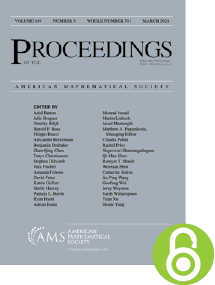The selfadjoint operators of a von Neumann algebra form a conditionally complete lattice
HTML articles powered by AMS MathViewer
- by Milton Philip Olson PDF
- Proc. Amer. Math. Soc. 28 (1971), 537-544 Request permission
Abstract:
The bounded resolutions of the identity in a von Neumann algebra can be ordered by $\{ {E_S}(u)\} \preccurlyeq \{ {E_T}(u)\}$ if ${E_S}(u) \geqq {E_T}(u),u \in R$. The selfadjoint operators in the algebra are partially ordered by this relation and are shown to form a conditionally complete lattice. The lattice operations are (essentially) defined by ${E_{V{S_\alpha }}}(u) = \wedge {E_{{S_\alpha }}}(u)$ for all $u$ contained in $R$. This order is called spectral order and agrees with the usual order on commutative subalgebras. For positive operators, $S$ is greater than or equal to $T$ in spectral order if and only if ${S^n}$ is greater than or equal to ${T^n}$ in the usual order for all $n \geqq 1$. Kadison’s well-known counterexample is shown to fail. The operator lattice defined by spectral order differs from a vector lattice in the fact that $S \succcurlyeq T$ does not imply that $S + C \succcurlyeq T + C$.References
- Richard V. Kadison, Order properties of bounded self-adjoint operators, Proc. Amer. Math. Soc. 2 (1951), 505–510. MR 42064, DOI 10.1090/S0002-9939-1951-0042064-2
- B. A. Lengyel and M. H. Stone, Elementary proof of the spectral theorem, Ann. of Math. (2) 37 (1936), no. 4, 853–864. MR 1503314, DOI 10.2307/1968623
- S. Sherman, Order in operator algebras, Amer. J. Math. 73 (1951), 227–232. MR 42065, DOI 10.2307/2372173
Additional Information
- © Copyright 1971 American Mathematical Society
- Journal: Proc. Amer. Math. Soc. 28 (1971), 537-544
- MSC: Primary 46.65
- DOI: https://doi.org/10.1090/S0002-9939-1971-0276788-1
- MathSciNet review: 0276788


